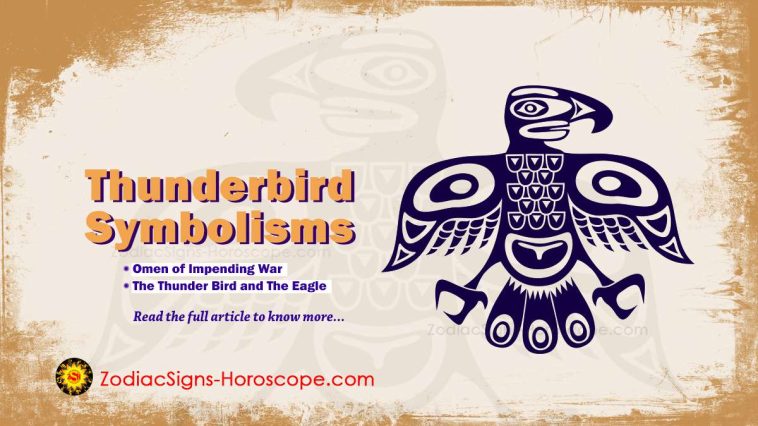Learn About The Thunderbird Symbolism and Its Meaning
The Native Americans were deeply spiritual people who used their elaborate system of symbology to communicate their history, beliefs, and ideas through geometric portrayals of animals, celestial bodies, and naturally occurring events. To the Plains and Sioux group tribes, the Thunderbird Symbolism was of particular importance. This gargantuan bird is typically portrayed as a large raptor-like bird with curling horns, a long beak, and a featherless head – a truly terrifying combination. Its name was thought to have evolved as a result of its behavior and the bold and frightening natural events that it caused.
Furthermore, lightning was also thought to be shot from its eyes and beak to punish liars and sinners. Although each geographical region had its specificities regarding the Thunderbird, there are several universal themes. The creature was believed to represent, such as divine rule, domination, and the strength of the spirit. The transmission of messages from other worlds, and above all, power.
Understanding the Meaning and Symbolism of Thunderbird
Omen of Impending War
Like all other Native American symbols, the interpretation of the Thunderbird varies in meaning from one tribe to another. Some viewed the cry of the Thunderbird (or thunder) as an omen of impending war. Within this perspective, it was quite common to find the enormous and powerful bird engraved on weaponry and at the burial sites of soldiers. Thunderbirds were thought to have massive open wings whose beating caused the winds to stir and thunder to shake the skies. This was believed to be a sign of the spirits engaging in war in the sky.
However, some also thought that it was a sign that victory would be had for the tribe fighting on the ground. Especially if the tribe had been adhering to the necessary rituals and dances. When the roaring thunder was heard, tribespeople constructed war huts made of cedar to begin the appropriate reverence ceremonies – the cedar tree was thought to be sacred to Thunderbirds.
Tobacco
Tobacco was also believed to be a sacred vice of this war bird and would thus be smoked in a precise ritualistic fashion. Many Native Americans viewed the rising smoke as symbolic of the brave departed warriors’ souls ascending to the heavens. This was both encouraging before the battle and comforting, as it was almost like a “last rite” before death.
Other tribes had a more peaceful outlook on the great Thunderbird. So, viewing it as the supreme Creator and almighty spirit of nature. This bird was always viewed as a solar symbol, a sect of ideology that every Native American tribe held dear. The sun was of the utmost importance for crop growth and thus survival. So, anything associated with it was viewed as most sacred. Many groups believed that the sun rose from the eyes of the Thunderbird, signifying a new day.
Creation
Likewise, when this bird closed its eyes to slumber, the darkness of night prevailed. Because of this perceived degree of control, the Thunderbird was largely connected with creation. It was the dominator of all natural activity and could control any aspect of nature. Appropriately, this meant that it deserved unmatched honor and praise at all costs. Although it was primarily a solar symbol (and thus a sign of light and warmth). This Creator was also in charge of another essential natural phenomenon: rain.
The Native Americans understood the life-giving properties of water and conducted countless ceremonies and rituals to summon rain from the Creator. Only when the Thunderbird was completely appeased would the world be blessed with this gift. Native Americans recognized that along with possessing the power of creation came the sovereignty of destruction. Thus, if they did not please the Thunderbird, storms, floods, droughts, and other natural disasters could and would be brought down upon them as punishment.
The Thunder Bird and The Eagle
The Thunderbird symbol also dominated Native American art, oftentimes in the form of an eagle. Many tribes carved this creature atop their totem poles to denote its ultimate status and that it reigns supreme over all things. As stated before, cedar was thought to be held sacred by the Thunderbirds, providing them with protective forests to dwell in. Fittingly, tribes of the Pacific Northwest used cedar to create their totem poles as a sign of respect and reverence for the chief spirit.
Other tribes, including the Haida, created masks in the image of the Thunderbird to represent their belief. The human soul could be honored by taking on this form at some point. Great people of the tribe were thought to be visited by the Creator on their deathbeds. Their souls then being carried away to the holy cedar forests.
Conclusion: Thunderbird Symbolism
Thunderbird symbolism certainly varies from region to region, tribe to tribe, and even individual to individual. However, one thing is certain: this bird was and continues to be a powerful symbol of nature’s dominion over mankind.


